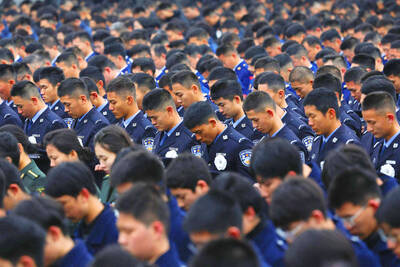Winter hit US honeybees hard with the highest loss rate yet, an annual survey of beekeepers showed.
The annual nationwide survey by the Bee Informed Partnership found that 37.7 percent of honeybee colonies died this winter, nearly 9 percentage points higher than the average winter loss.
The survey of nearly 4,700 beekeepers managing more than 300,000 colonies goes back 13 years and is conducted by bee experts at the University of Maryland, Auburn University and several other colleges.

Photo: AP / Dale Young / Detroit News
Beekeepers had been seeing fewer winter colony losses until now, Dennis van Engelsdorp, president of the bee partnership and coauthor of the survey, said on Wednesday.
“The fact that we suddenly had the worst winter we’ve had ... is troubling,” van Engelsdorp said.
Some bees usually die over winter, but until the past couple decades, when a combination of problems struck colonies, losses rarely exceeded 10 percent, he said.
Bees pollinate US$15 billion of US food crops. One-third of the human diet comes from pollinators, including native wild bees and other animals, many of which are also in trouble, according to the US Department of Agriculture.
“We should be concerned on multiple levels,” said University of California, Berkeley, agricultural social scientist Jennie Durant, who released a separate study this week on loss of food supply for bees.
Year-to-year bee colony losses, which include calculations for summer, were 40.7 percent higher than normal, but not a record high, the survey found.
“The beekeepers are working harder than ever to manage colonies, but we still lose 40 to 50 percent each year... Unacceptable,” said Swiss bee expert Jeff Pettis, who was not part of the survey.
For more than a decade, bees have been in trouble with scientists blaming mites, diseases, pesticides and loss of food.
This past winter’s steep drop seems heavily connected to mites, van Engelsdorp said.
Beekeepers report that chemicals that kill mites do not seem to be working quite as well and mite infestation is worsening, he said.
Those mites feed on the bees’ fats, where the insects store protein and center their immune response.
Durant’s study in this week’s Land Use Policy found that changes in food supply in the Midwest’s Prairie Pothole Region, a hot spot for honeybee colonies, has been a major factor in losses. That area has lost wetland areas with clover bees feed on.
Other areas have been converted to corn and soy crops, which do not feed bees, she said.
“We’re not really worried about honeybees going extinct... I’m more worried that the commercial beekeepers will go out of business,” van Engelsdorp said.

PARLIAMENT CHAOS: Police forcibly removed Brazilian Deputy Glauber Braga after he called the legislation part of a ‘coup offensive’ and occupied the speaker’s chair Brazil’s lower house of Congress early yesterday approved a bill that could slash former Brazilian president Jair Bolsonaro’s prison sentence for plotting a coup, after efforts by a lawmaker to disrupt the proceedings sparked chaos in parliament. Bolsonaro has been serving a 27-year term since last month after his conviction for a scheme to stop Brazilian President Luiz Inacio Lula da Silva from taking office after the 2022 election. Lawmakers had been discussing a bill that would significantly reduce sentences for several crimes, including attempting a coup d’etat — opening up the prospect that Bolsonaro, 70, could have his sentence cut to

China yesterday held a low-key memorial ceremony for the 1937 Nanjing Massacre, with Chinese President Xi Jinping (習近平) not attending, despite a diplomatic crisis between Beijing and Tokyo over Taiwan. Beijing has raged at Tokyo since Japanese Prime Minister Sanae Takaichi last month said that a hypothetical Chinese attack on Taiwan could trigger a military response from Japan. China and Japan have long sparred over their painful history. China consistently reminds its people of the 1937 Nanjing Massacre, in which it says Japanese troops killed 300,000 people in what was then its capital. A post-World War II Allied tribunal put the death toll

A passerby could hear the cacophony from miles away in the Argentine capital, the unmistakable sound of 2,397 dogs barking — and breaking the unofficial world record for the largest-ever gathering of golden retrievers. Excitement pulsed through Bosques de Palermo, a sprawling park in Buenos Aires, as golden retriever-owners from all over Argentina transformed the park’s grassy expanse into a sea of bright yellow fur. Dog owners of all ages, their clothes covered in dog hair and stained with slobber, plopped down on picnic blankets with their beloved goldens to take in the surreal sight of so many other, exceptionally similar-looking ones.

‘UNWAVERING ALLIANCE’: The US Department of State said that China’s actions during military drills with Russia were not conducive to regional peace and stability The US on Tuesday criticized China over alleged radar deployments against Japanese military aircraft during a training exercise last week, while Tokyo and Seoul yesterday scrambled jets after Chinese and Russian military aircraft conducted joint patrols near the two countries. The incidents came after Japanese Prime Minister Sanae Takaichi triggered a dispute with Beijing last month with her remarks on how Tokyo might react to a hypothetical Chinese attack on Taiwan. “China’s actions are not conducive to regional peace and stability,” a US Department of State spokesperson said late on Tuesday, referring to the radar incident. “The US-Japan alliance is stronger and more